1966 – 2016
Also known as Sea Princess (I), Victoria (II), Mona Lisa, and Oceanic II
Svenska Amerika Linien (the Swedish American Line), or SAL, had established themselves on the North Atlantic in the 1910s with the 12,000 gross ton liner Stockholm. By the Twenties, a fleet mate – Drottningholm – was added. The first newbuilds for SAL appeared in 1925 and 1928. They were the Gripsholm and Kungsholm, and they would become immensely popular among passengers. These two handsome liners served with distinction in World War II, but after the war they were both sold to foreign interests. By then, SAL had two new liners on the drawing boards.
The first of them appeared in 1953 and was given the name Kungsholm after her older fleet mate. She was of a totally new breed in exterior design – very different from the two vessels built in the Twenties. In 1957 a sister followed. She was named Gripsholm, and thus SAL once again operated a North Atlantic duo named Kungsholm and Gripsholm. These two liners were very similar in exterior design, but the interiors were somewhat different. Another major difference from the two older liners was that the new ships were built with cruising in mind. Trans-Atlantic business was still at its peak in the Fifties, but cruising became more and more popular.
The Kungsholm and Gripsholm continued the combined cruises and liner voyages until 1965 when the Kungsholm was sold to Norddeutscher Lloyd and renamed Europa. The Gripsholm remained a lone SAL-ship on the traditional Göteborg-New York route since the smaller 1948-built Stockholm had been sold in 1960. Operating only one ship was unimaginable for SAL, and they already had a new ship on the drawing boards.
The new ship would have a gross tonnage of somewhere in-between 26,000 and 27,000 – meaning it would be the largest ship ever operated by SAL. Back in 1940, they had had a 30,000-ton liner completed, named Stockholm, but she was sold to the Italians before deliverance to SAL because of the war, and was therefore never used by the Swedes.
The contract of building the new ship was given to the famous shipyard John Brown & Company in Scotland. On April 14, 1965, the new ship was launched and christened Kungsholm by Mrs. Annabella Broström. At the time of the launch it was evident that the Kungsholm would follow the exterior trend set by her earlier fleet mates. She would sport a white hull and two, ‘France-like’, funnels. The inside of the ship would be the most luxurious ever on a SAL-ship. The point where the Kungsholm would differ from older SAL-liners, was that she would be used almost exclusively for cruising with only little time of the year dedicated to the trans-Atlantic trade. On a trans-Atlantic crossing she would be able to carry 108 Cabin Class passengers and 605 in Tourist Class. On a cruise the entire complement was down to a mere 405.
The Kungsholm was powered by two nine-cylinder Götaverken Diesels, capable of giving the 26,678-ton ship a service speed of 21 knots – the fastest ship in the Swedish American Line’s history. However, on the first sea trials, which occurred on November 19, 1965, the Kungsholm reached the very impressive speed of 25 knots.
On March 17, 1966, the Kungsholm’s fitting out was completed and she was delivered to the Swedish American Line. Three days later she arrived at Göteborg harbour where cheering crowds and waterborne vessels heartily welcomed her. The breathtaking elegance of the Kungsholm was now evident to everyone. The two funnels were stepped, with the first one being slightly higher than the second. In order to take away some wind resistance, both funnels had a small wing aftwards, soon giving them the nickname ‘firemen’s hats’. Fortunately, these wings were very discrete – SAL did not want to end up doing the mistake the French Line had done with the France’s funnels. The whole Kungsholm had been given generous curves and the stern was considered by many as the most beautiful on the seas for many years. Its shape was close to the fantastic Normandie’s with the infalling superstructure over the hull. The Kungsholm was surely a white beauty of the seas, and would become known as ‘the vessel of the ages’. On April 22, 1966, the new ship started her maiden voyage in Göteborg. The destination was New York.
The fabulous interiors were of an entirely new breed for the Swedish American Line. The 300-seat auditorium had been moved up to the Veranda Deck where all the public areas were. The largest of the eighteen group facilities was the main lounge or the ‘Stora Salongen’. The room was an impressive 570 square metres and could accommodate 400 people.
Just as on the Gripsholm of 1957, the ship’s two classes – Cabin and Tourist – were merged into one on cruises. The aft smoking room, which belonged to the Tourist class on an Atlantic crossing, had a splendid view out over the large aft deck. The room was decorated with a maritime tapestry composed by Marianne Richter of the House of Märta Måås-Fjetterström.
The entire spacious swimming pool was lined in mosaics, shimmering of fantastic colours. Carl Harry Stålhane of the Rörstrand company had done the setting. If you cared to take a more private bath, you probably did not have to rent the entire swimming pool, since more than 90 per cent of the staterooms on board had bathtubs. The rest were equipped with showers. Burglar alarms were another feature that every cabin held.
The ship also had a grand outdoor swimming pool on the Lido Deck. This was the natural gathering space for the cruise passengers. Obviously, the pool was less used on the more chilly Atlantic crossings. During the fabulous world cruises the Kungsholm made later in her career, the main lounge was used for enormous smörgåsbord-parties. The room was certainly suited for such a large event, with its ceiling, overlaid with 24-carat gold. At the end of the room, the artwork ‘Midnight Sun’ decorated the room.
The Kungsholm led a very charming life in the fleet of the Swedish American Line together with the 1957-built Gripsholm until 1975. For some reasons, the main office in Göteborg then expected heavy losses within short and wanted to shut down SAL’s passenger business. The American branch protested and showed evidence that both Kungsholm and Gripsholm were, and would continue to be, highly profitable. But, as if it was God’s decision, the head office did not reconsider, and the Swedish American Line was dissolved during the latter half of 1975. The Gripsholm was sold to the Greek Karageorgis Lines and was renamed Navarino. The Kungsholm went to the Norwegian-owned Flagship Cruises under shipowners Per Lorentzen and Øivind Lorentzen. The price was given at 65 million Swedish Kronor – certainly a real bargain for Flagship Cruises. The Swedish American Line had paid circa 130 million for the ship in 1966, and that was nine years ago!
Flagship Cruises continued to operate the Kungsholm, bearing her original name and colours, until 1978 when they sold her to the famous P&O Line. They transferred the ship to British flag, and on September 4, 1978 the vessel arrived at Vegesack, Germany for refitting by Bremer Vulcan. On January 15 the following year, the ship was renamed Sea Princess. A month later, on February 16, she made her maiden cruise for P&O with a gross tonnage of 27,670. The voyage went between Hong Kong and Sydney.
The refit P&O did to the former Kungsholm was by many considered as incredibly boneheaded. In order to ‘modernise’ the ship, P&O decided on removing the forward funnel and rebuilding the after one into a bizarre and inefficient cone. This alteration transformed one of the most beautiful liners ever to sail the oceans into a mediocre, strange looking cruise ship.
In 1982, the Sea Princess underwent yet another conversion. Additional accommodation was built in by Vosper Limited at Southampton, increasing the passenger capacity to 840 people. After her return to service, she was removed from the Far East and Australian cruise routes and placed in European waters. Between 1986 and 1991 she sailed under Princess Cruises’ banner alongside with the Canberra, but after that she once again gained P&O’s buff funnel.
In order to free the name Sea Princess for a P&O-newbuild, the ship was renamed Victoria in April 1995. She was the second P&O vessel with that name. The first Victoria had been the first of the four ‘Jubilee Class’-liners commissioned in 1887.
In December 1999, the revived Union-Castle Line chartered the Victoria for a voyage celebrating the company’s centennial anniversary. She was selected because of her resemblance to the old Union-Castle steamers. Like so many previous Union-Castle ships, the Victoria’s voyage went down the west side of Africa to Cape Town returning via East Africa and the Spice Islands of the Indian Ocean. Some 750 fortunate passengers resided on the Victoria during this historical voyage. After the voyage, Victoria was returned to P&O.
By late 2000, rumours about that the Victoria would be sold was circulating. The future for the 34-year-old ship did not look very bright, as P&O was not very interested in selling the profitable ship to any of their rivals.
But, in 2002 a new stage of the old Kungsholm’s career begun. She was sold to Paris Katsoufis and was eventually chartered to the German company Holiday Kreutzfahrten, with the contract ranging to 2007. Renamed Mona Lisa, she now sported a new livery, featuring a reproduction of her namesake painting emblazoned on her funnel. She would remain in this guise for a few more years, but in 2007 the ship was transferred to a new company, this time chartered by Royal Caribbean Cruises Ltd. and renamed Oceanic II. That spring, she was then sub-chartered by Louis Hellenic Cruises as a temporary replacement for their ship Sea Diamond, which had ran aground and sunk in April 2007.
Still under the name Oceanic II, the ship spent a year as an educational vessel, offering undergraduate and graduate semester programs ranging four-month voyages. The program was discontinued in 2008, however, and the vessel reverted to the name Mona Lisa. Operated by a German company, the Mona Lisa suffered a mishap in May 2008, when she was grounded in the Irbe Strait while leaving the port of Riga, in Latvia. Passengers had to be evacuated, and the ship was pulled from the sandbank a few days later. After a drydock inspection in Ventspils, she was returned to traffic.
The Mona Lisa spent a few more years under charter, but new SOLAS regulations coming into effect in 2010 cast doubt on her continued service. Swedish entrepreneur Lars Hallgren signed a letter of intent to purchase the ship and return her to Gothenburg as a floating hotel, refurbished in her original appearance as the Kungsholm. Unfortunately, Mr. Hallgren was not able to secure a permanent mooring for the ship, since the city of Gothenburg would not offer anything more than a five-year lease. In the end, the deal fell through, as did a similar plan to bring the ship to Stockholm instead.
Her return home to Swedish waters cancelled, the Mona Lisa was instead brought to Oman and put to use as an accommodation ship. Renamed Veronica, she was later given a refit and served for three years as a floating hotel at Duqm.
By autumn 2015, however, the ship was put up for sale. Again, there was an initiative to bring the former Kungsholm back to Gothenburg, this time by businessman Johnny Sid. While he was somewhat successful in securing funds for the purchase, the city of Gothenburg was once again unwilling to provide a berth. Negotiations continued, even as a bid from scrappers was accepted and the ship began her final voyage, under tow by the tug Kamarina. The hopes of saving the ship were kept alive until the bitter end, but once the former Kungsholm had been beached in Alang, there could be no return. In May 2016, the work of cutting up the last White Viking began, definitely ending a stellar career that had spanned half a century.
Specifications
- 660 feet (201.6 m) long
- 86 feet (26.3 m) wide
- 26,678 gross tons
- Two Götaverken diesels powering two propellers
- 21 knot service speed
- Passenger capacity of 713 people on trans-Atlantic crossings, 405 people during cruises

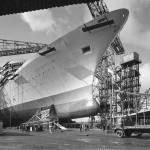
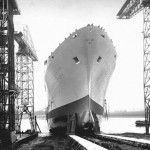
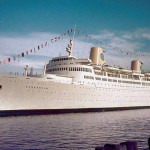
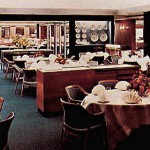
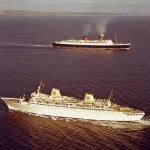
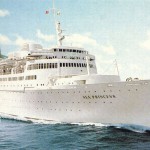
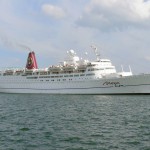
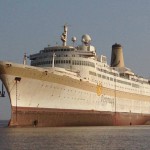
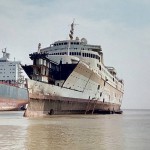
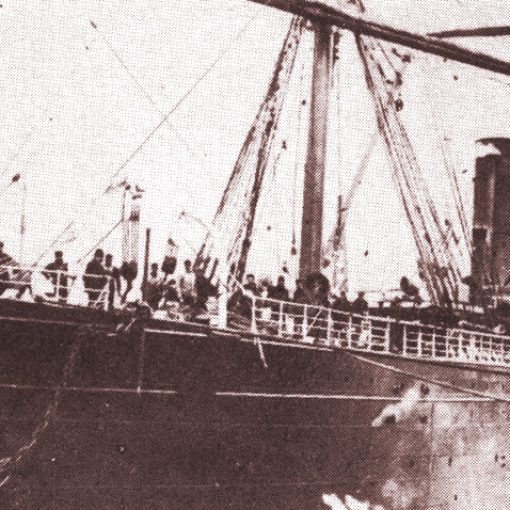

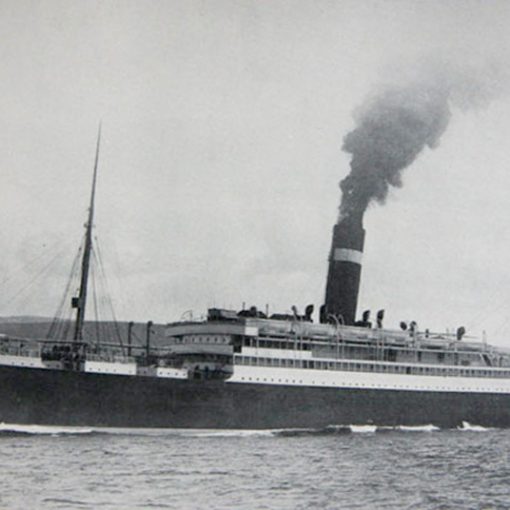
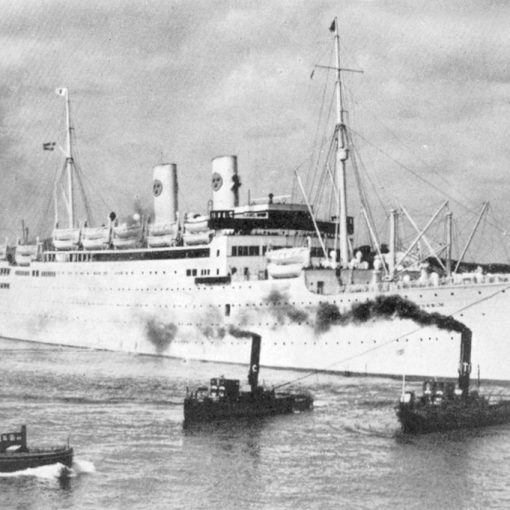
2 thoughts on “Kungsholm (IV)”
As much as I adore the Normandie, the Rex, the Cristoforo Columbo, the Andrea Doria, the SS United States, the Wilhelm Gustloff etc., there’s something about the Kungsholm’s sleeker lines that hoist her to number one in the top ten most beautiful liners category. She only became known to me in recent years and I did a double take when I first laid eyes on her. I understand she resides in Dubai now but for how long? If I had all the funds in the world, I would see her return to her glory days. She deserves that much! Any billionaires out there, wishing to support a great cause? ; ) Beauty ought not be allowed to be pushed aside by grotesque aquafit city blocks! We have our fill of aesthetic blight already. I for one do not wish permission to come aboard!
Personally, I hold the Normandie a bit higher than the Kungsholm, but they were indeed lovely looking vessels! However, the Kungsholm is not in Dubai, since she was sent to the breakers in 2016. There was an effort to save her and bring her back to Gothenburg, but lack of political support made the venture impossible in the end. Perhaps you have her confused with the QE2, who resides in Dubai and was recently opened as a hotel.